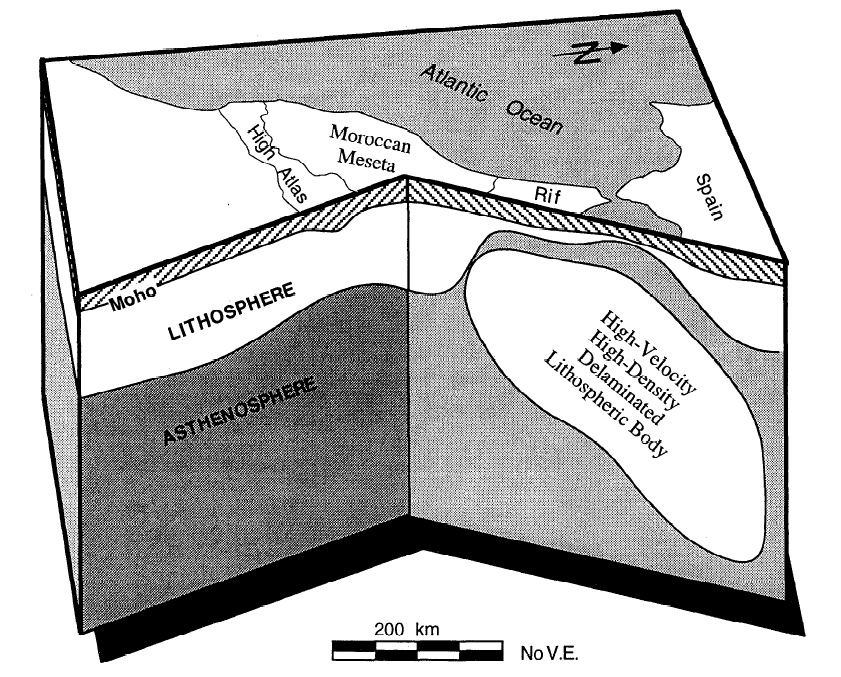Home |
Publications
Seber, D., Barazangi, M., Tadili, B., Ramdani, M., Ibenbrahim,
A., and Ben-Sari, D.
Three-dimensional upper mantle structure beneath the intraplate Atlas and
interplate Rif mountains of Morocco
Journal of Geophysical Research, 101, 3125-3138, 1996.
Abstract
We integrate observations based on teleseismic
P wave travel times and available geologic data to infer that the lithosphere
beneath the intraplate Atlas mountains is thin and/or it is characterized by lower
P wave velocities, while beneath the interplate Rif mountains and the adjacent
Alboran Sea a previously thickened lithosphere has been delaminated into the upper
mantle. Using surface geology and geochronology data, previous studies have proposed
that lithospheric delamination took place in this region. In this study we show
through analysis of teleseismic P wave residuals the existence of a high
velocity (>3%) upper mantle body, which is interpreted to be the delaminated,
rigid lithosphere. This high-velocity layer is overlain by a very low velocity
uppermost mantle material replacing the delaminated lithosphere. Teleseismic P
waves recorded by a recently installed digital seismic network and an older analog
network in Morocco provide the residuals database. A total of 734 P wave
residuals from 92 selected teleseismic earthquakes are used to document the spacial
pattern of upper mantle velocity structure beneath northern Morocco and the Alboran
Sea. Subsequent use of these residuals in a tomographic inversion scheme produced
a three-dimensional velocity image of the upper mantle. We infer from the P
residuals that strong upper mantle velocity anomalies exist beneath both the Rif
and Atlas regions. The Rif stations show negative residuals (- 1-1.5s) for ray
paths from the east and northeast and show positive residuals (~ 1-1.5s) for raypaths
from the northwest and southwest. Tomographic results indicate the existence of
a high-velocity body (~ 3% higher velocities) in the upper mantle beneath the
eastern Rif and Alboran Sea, extending approximately from subcrustal depths down
to a depth of at least 350 km. In the western Rif, however, 1-2% lower velocity
material is imaged in the upper mantle. The residuals of the Atlas stations also
show azimuthal variations. In general, most of the P waves that travel beneath
the High and Middle Atlas have about 0.5-1.0s delays. In contrast, the rays that
travel beneath the northwestern margin of the Atlas mountains and the adjacent
Moroccan Meseta area show negative residuals (~1s), suggesting that higher velocity
material exists beneath the platform area adjacent to the Atlas mountains. Tomographic
results indicate that beneath most of the Atlas system the uppermost mantle has
about 1% lower velocities. Beneath the Alboran Sea region, however, reported low
uppermost mantle Pn velocities contrast strongly with higher velocity upper mantle
velocities obtained by our analysis. Low-velocity uppermost mantle beneath the
Alboran Sea underlain by a high-velocity upper mantle material is used to support
earlier interpretations of lithospheric delamination beneath the Rif and Alboran
Sea Regions. The enigmatic occurrence of subcrustal earthquakes in these regions
is also consistent with this active delamination mechanism.
Copyright Statement
An edited version of this paper was published
by AGU. Copyright 1996 American Geophysical Union.
Link to JGR
Key Figures and Captions
Figure 11. A schematic representation of the interpreted cross
section across the Atlas and Rif/Betic regions. This interpretation is meant
to show a gross upper mantle structure based on analysis of teleseismic residuals.
Lithospheric thinning beneath the Atlas is inferred from the positive residuals.
Beneath the Rif and Alboran Sea regions teleseismic P wave residuals
and tomographic inversion results show that high-velocity material exists in
the upper mantle. Very low Pn velocities in the uppermost mantle are overlain
by high-velocity upper mantle material. In a recent study Seber et al.
[1996] discussed the occurrence of intermediate-depth earthquakes beneath the
Alboran Sea and surrounding regions and the presence of a seismic gap in the
uppermost mantle beneath the Alboran Sea region.

Home
| Publications

